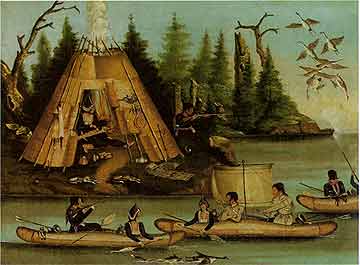The Sign of the Beaver

Elizabeth George Speare’s The Sign of the Beaver (1983) is a popular children’s book commonly used in the classroom as a way of introducing students to the Native Peoples of Maine.
Aspects of the material culture of Maine’s Native People presented in The Sign of the Beaver can be explored through the Hudson Museum’s exhibit, Penobscot Primer Project and through the Hudson Museum’s online exhibits on this website. Objects that appear in both the book and the exhibit include, crooked knives (39-40), a fish spear (49), a bow (61), birchbark canoes (77), birchbark wigwams (78), examples of Penobscot dress for men and women (78), a beaded collar (79), sweetgrass (96), birchbark containers (100), a waltes game (100), and snowshoes (116). Speare’s discussion of Wabanaki tales may be enhanced by sharing Creation legends published in The Wabanakis of Maine and the Maritimes (1989) with your students. To order this and other educational resources that support the teaching of Wabanaki History and Culture, please visit the Wabanaki Study Unit for links to web-based resources and a selection of recommended books, videos and audio support material. As part of the gallery program for the Penobscot Primer Project, students may view the traditional Penobscot tale, The Frog Monster. This video, by students at Indian Island School, recounts Gluskabe’s encounter with a water-greedy frog. The production, a clay and paper animation, shows scenes of traditional Penobscot life as well as telling the story of the creation of the Penobscot River.
Students visiting the Penobscot Primer Gallery will also learn about and listen to the Penobscot language through an interactive computer program. Learn more about the project and hear a sample of the Penobscot language spoken by Madeline Shay, the last fluent Penobscot speaker by visiting the Penobscot Primer Project online.
Speare makes the point in The Sign of the Beaver that objects the Penobscots traditionally used were handmade from natural resources immediately available to them. By the late 1700s, the Penobscots had readily adopted many objects—metal tools, guns, knives, iron kettles, cloth and glass beads—brought by European settlers and incorporated them into their culture. During onsite visits, students may look at the Hudson Museum’s exhibit, which features objects made in the 19th and 20th centuries, and determine which objects were made from indigenous resources and which were not.
For classroom discussion
The Sign of the Beaver, a historical novel published in 1983, focuses on the relationship of two boys, one the son of a Anglo settler and the other a Penobscot boy. The book centers on how the two exchange aspects of their culture, teaching one another to survive. Since the book was published, aspects of the book merit special discussion with your classes.
Teachers should caution students about the derogatory nature of the word “squaw” and discuss recent Maine legislation pertaining to the use of this term.
Students should also discuss how Native People are portrayed in the book. Native American characters in The Sign of the Beaver speak in “pidgin.” Historical documents from the 1760s clearly indicate that Maine’s Native People spoke “proper” English and engaged in complex negotiations with non-Native peoples. Examples of letters written by Wabanakis and transcripts of negotiations between Maine Indians and Europeans and Americans are to be found in vols. 23 and 24 of the Documentary History of Maine, edited by James Phinney Baxter. For further discussion about Native American stereotyping prevalent in the book, please read The Sign of the Beaver: The Problem and the Solution by Sanda Cohen published in American Indian Stereotypes in the World of Children: A Reader and Bibliography, second edition, Arlene Hirschfelder, Paulette Fairbanks Molin and Yvonne Wakim, editors, The Scarecrow Press, Inc., Maryland, 1999.
The Sign of the Beaver ends with the Native Peoples who traditionally lived in central Maine moving further inland as white settlers encroached on their traditional territory. The impression left is that of a culture in decline and disappearing. Teachers can use The Wabanaki of Maine and the Maritimes to discuss Maine’s four Federally recognized tribes today, as well as visit websites for each of the tribes and the Maine Indian Basketmakers Alliance.
In using The Sign of the Beaver in your classroom, we hope you will consider:
• incorporating the suggestions in this Curriculum Connection
• visiting our Curriculum Connection for Maine Basketry
• visiting our Curriculum Connection Tree and Tradition: Maine Indians and the Forest
• utilizing our Maine Indians: Curriculum Resource List
• visiting the Hudson Museum for a Penobscot Primer Project tour and gallery program. See our programs page for information about scheduling tours and programs
• borrowing The People of the Dawn or Penobscot Images classroom exhibits. To learn how, visit our classroom exhibits page.
